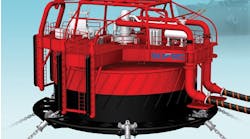Following recurring handling problems with jacket installations, a Chinese operator turned to Samson Rope for help with a project in the South China Sea using slings with Dyneema fiber.
China Offshore Oil Engineering Corp. (COOEC) had installed numerous jacket structures in this region, some weighing up to 20,000 tons (18,143 metric tons). All had relied on the use of traditional lifting slings manufactured from steel wire.
Although wire slings are strong, the company found them heavy to handle and occasionally dangerous during attempted placements in the rough seas that can occur in this region.
Jacket with lifting slings.
For an operation in the Pu Yan gas field last Septembter, COOEC sought a solution that would lead to a faster, more secure, and more efficient installation. In this case, the jacket, weighing 16,213 metric tons (17,872 tons), had dimensions of 75 x 75 m (246 x 246 ft) and a height of over 213 m (699 ft).
The four lifting slings employed for the job were fabricated by Gaylin International using 120-mm (4.7-in.) diameter Samson Quantum-8 synthetic ropes. The ropes were made from DPX, a patented blend of polyester and lightweight, high-strength Dyneema polyethylene fiber. According to Jorn Boesten, DSM Dyneema’s market segment manager offshore: "As the Dyneema fiber is the strength member in this blend, the slings stretch only very slightly, similar to steel wire, thereby offering good control for the crane driver."
In line with client specifications, Gaylin also supplied spliced grommets with protected eyes on both ends, along with extra protection for the mid-body of each sling. Subsequent testing of the completed slings in Singapore was witnessed by ABS.
Urmond-based DSM Dyneema claims the properties of its fiber provide strength 15 times greater than that of steel. Therefore, lifting slings incorporating the fiber can be manufactured in the same diameter as comparable steel wire slings, but with only one-fifth of the weight.
For the Pu Yan jacket, the lengths of the slings were 2 x 82 m (2 x 269 ft) and 2 x 78.5 m (2 x 257.5 ft). The weight was just below 700 kg (1,543 lb) for each sling. "Wire equivalents would easily have weighed more than 40 kg/m (26.8 lb/ft)," says Dyneema’s market segment manager Offshore, Jorn Boesten.
COOEC installed the jacket using a floating crane vessel supplied by Guangzhou Salvage. The operation went smoothly, with no reported mishaps or injuries to the crew.
"The ropes were excellent because of the light weight," says Hi Huai Lang, technical manager of Offshore Installation. "Compared with steel wire and synthetic webbing slings, the ropes have better operational advantages because during operation, especially when hooking up our sling to the lifting point, they can be handled manually.
"In the past, when we were using wire rope slings in rough seas, many of our attempts were delayed and sometimes even abandoned as it would have taken too much time."
One reason for the ease of handling is that Samson’s DPX technology has a higher co-efficient of friction for better grip, resulting in a shorter splice termination. Also, the Dyneema fiber makes the slings neutrally buoyant in seawater, aiding productivity as well as operator safety.
Dyneema is said to be highly resistant to exposure to ultraviolet radiation, chemicals, and salt water, so in this case the lifting slings are less likely to be affected by the elements, and they also can be re-used repeatedly.




